
Eating my way in NYC
I had a work trip to NYC last week, and tried a few places that were all the hype (more reviews to come).
I’m happy to report back I was so pleasantly impressed by Wen Wen in Brooklyn!
The place was saved on my Google Maps after reading fellow Taiwanese on Threads. I had no idea it was also recommended by the New York Times (which I take with a grain of salt when it comes to Asian food) and featured on the Michelin Guide.
We happened to be in Brooklyn for an improve show, and were hungry after. It was late when we got to Wen Wen, and guests were wrapping up and getting ready to leave. The staff at the bar were nice enough to take us 40 minutes before they were about to close.
The vibe was very similar to a fun Taiwanese fusion restaurant you’d find in Taipei — one that blends iconic old local elements with a modern twist. It reminded me of some of my favorite places in Taipei — like Chán Shífān. This is what people in Taiwan would describe as Wen Ching — a hipster equivalent in the US.
Stinky tofu (minus the stink) and still delicious 酥炸嫩豆腐

The tofu resembled the (in)famous stinky tofu 臭豆腐 that is loved by most Taiwanese and dreaded by foreigners.
Like all good hospitable Taiwanese, I take great pride in introducing stinky tofu to visitors.
What I usually get ranges from “Oh no thanks” to “hmm that’s interesting” to “it’s actually not that bad, it’s like a very stinky [insert cheese here] / that Swedish fish that’s super stinky…”
But no, I don’t I’ve ever successfully converted anyone into a stinky tofu enthusiast.
Being a true Taiwanese means you crave for stinky tofu…both deep-fried and steamed. It means you’re willing to line up for it at a night market, find hidden late-night food trucks with friends, or travel all the way to Shen Keng — the “capital of stinky tofu” — just for that unexplainably delicious fermented sewage-like smell.
It’s the combination of the deep-fried crispy exterior, silky soft interior, peppery, salty, and sometimes spicy taste, topped with refreshing pickled cabbage, that gives this food its addiction factor.
While Wen Wen’s deep-friend tofu is by no means stinky, it embodies the essential flavors that someone would love stinky tofu for. It is a clever take to make an acquired taste more approachable to the masses.
Cold sesame noodles, but fancier! 香辣麻醬麵

The sesame cold noodles were my husband’s favorite — a more refined take on a national staple (you can literally find a Liang Mien 涼麵 restaurant in every neighborhood in Taiwan). Liang Mien typically comes with shredded cucumber and other veggies like shredded carrots and bean sprouts, topped with rich sesame/peanut paste and minced garlic. Combined with miso soup (usually with egg drop), the $2 dollar meal is a perfect solution for hot and humid days when you’ve lost all appetite.
Wen Wen’s Liang Mien reminds me of the ones from Meowvelous in Taipei (my all-time favorite). Not in the sense that they use similar ingredients (Meowvelous uses pork strips instead of the traditional egg strips, and replaces cucumber with scallion. They also are lighter on the sesame paste), but rather they both attempt to turn your everyday food sophisticated and restaurant-ready.
I’m a bit picky when it comes to my Liang Mien, so here’s what I think they could’ve done better:
- The egg strips are a bit too thick for my liking, but if you make your own Liang Mien, you know the egg strips can be quite time-consuming to make.
- The consistency of the sesame paste — I find it too watery, leaving a tad too much liquid in the bowl (though without making the noodles soggy).
- The shredded cucumber was good, but I wish it was crunchier — maybe because we were the last guests that day and the cucumber might have reached the end of its crunchiness. One pro-tips on cucumbers if you’re making Liang Mien at home — always hand-cut to retain crunchiness. Never use a shredder as you end up with a lot of liquid.
Lu Rou Fan / Lo Ba Beng (Braised Pork Rice) 滷肉飯

This is yet another attempt to transform a national staple in a playful manner.
I like they name this dish after its Taiwanese name Ló͘-bah-pn̄g (which pronounces Lo Ba Beng) and not the more common Mandarin name Lu Rou Fan 滷肉飯. It is more fun this way!
If Wen Wen is your first Ló͘-bah-pn̄g, you will easily fall in love with this. It’s rich, meaty, sweet, savory, sour, chewy and crunchy all in the same bite. It is fun and full of surprises.
For someone who grew up eating all variations of Ló͘-bah-pn̄g, I find myself preferring the traditional version.
Ló͘-bah-pn̄g is our soul food. It is believed that back in the days when people were poor, they couldn’t afford pork in whole cuts, so they would ask chop up scraps, fat trimmings and skin, and braise them with soy sauce. This is a heavy topping that goes well with the maximum amount of rice — making it a cheap but satisfying meal.
Wen Wen’s Lo Ba Beng is leaner than traditional Taiwanese Ló͘-bah-pn̄g and it is extremely generous with the meat — which I find off balance as it left too much sauce at the bottom and made the rice a bit soggy. But I get it, if people are paying $18 for this, they would not be happy to be served a traditional Ló͘-bah-pn̄g with scant fatty braised pork over a big bowl of rice.
Wen Wen’s Lo Ba Beng is fancy — not just in terms of price, but the sides. They did their soy marinated soft-boiled eggs right (though in Taiwan the eggs would be well-done, but I do like it a bit runny), and they added a few slices of the highlighter yellow Takuen (Japanese picked daikon radish) - things you’d find in a traditional Ló͘-bah-pn̄g. The picked mustard greens and cilantro are by no means common though. Picked mustard greens are typically used in Beef Noodles, but not Ló͘-bah-pn̄g. And cilantro is as polarizing as politics in Taiwan (I am team cilantro, just for the record).
Our waiter told us Lo Ba Beng is a customers’ favorite (maybe second to popcorn chicken — which we didn’t order), but it ended up being our least favorite that night. Still, it beats most Ló͘-bah-pn̄g/Lu Rou Fan I’ve had in the U.S. (oh the bar is so low…)
Dong Bei Salad 東北老婆沙拉

I’m not sure why they named it “Wifey salad” in Mandarin — I can only assume it’s the “Bei” (bae?) in Dong Bei.
We ordered this because we needed some veggies but didn’t feel like another stir fry dish (debated whether we should get their Peashoots w/ Tofu Skin but landed on a cold dish instead).
The wood ear mushroom (Mu-er 木耳) added the much needed texture. I’m a big fan of adding peanuts…it reminds me of cabbage stem salad with peanuts frequently found in restaurants in Taipei. Overall, the dish is refreshing, but I wish their napa cabbage strips had absorbed more seasoning — as they felt a bit too watery.
Wen Wen is delicious, fun, modern, and nostalgic — all in one
I didn’t realize the owners of Wen Wen are the chef and restauranteur duo Eric Sze and Andy Chuang who own the famous 886 — a well-known Taiwanese street-style stir-fry restaurant on the Lower East Side. 886 has been on my list for years, but somehow I stumbled upon Wen Wen first.
The exterior feels homey and inviting, and as soon as you walk in, you are transported to a hip place you’d find in Taipei.
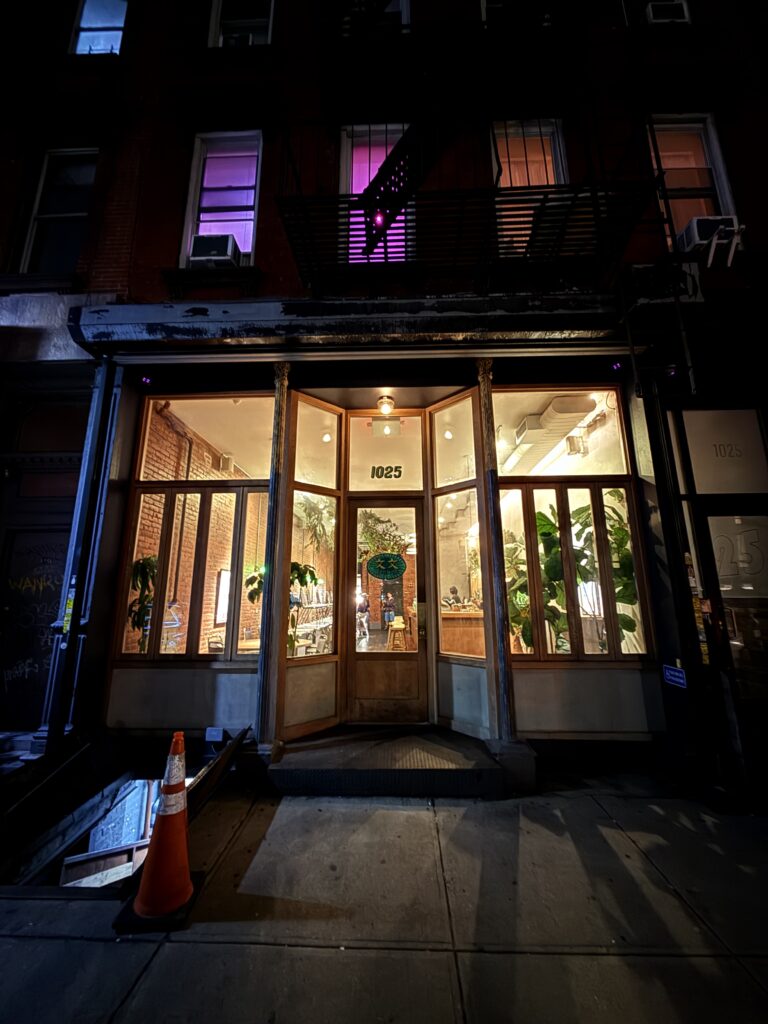
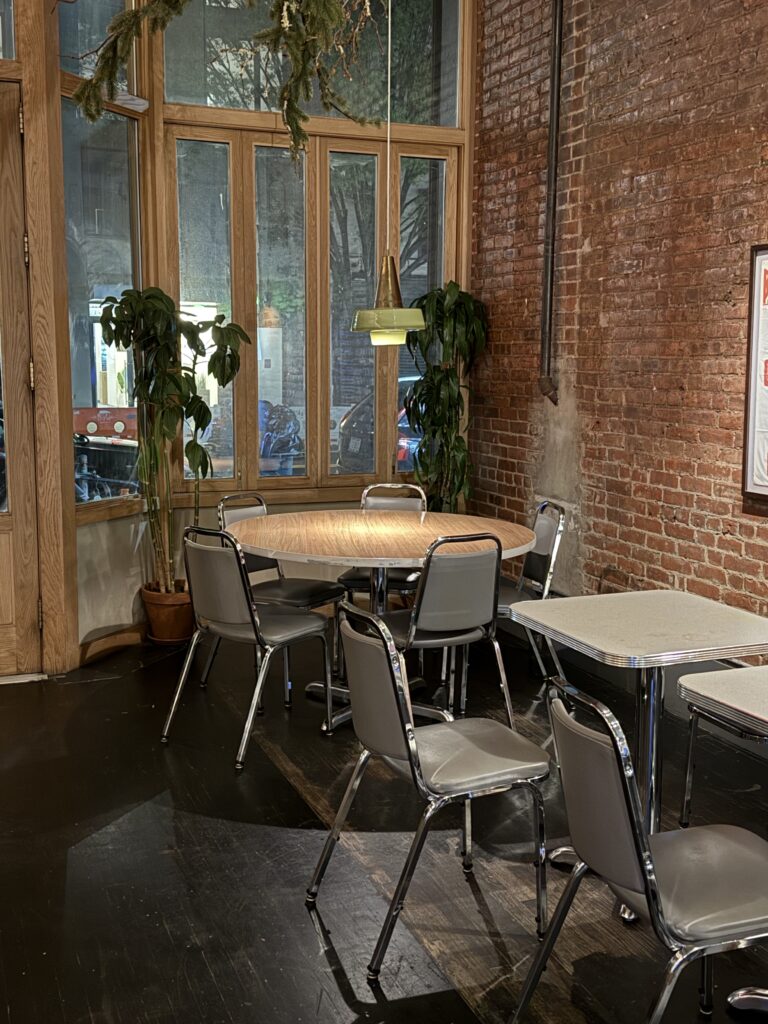




The playlist features both classic Taiwanese ballads and groovy hip-hop like DJ Didilong. Waiter told us the owners are very particular about the music selection and do not want people to mess with it — which I 100% understand and respect.
Their bathroom is super fun — reminiscent of an old disco dance club or a cheap karaoke bar. And the music played in the bathroom is different from the one played in the restaurant. Super cool.
The red chopsticks…
One last fun fact for y’all before we go. Wen Wen’s red chopsticks are paying homage to Taiwan — they’re the same (or maybe just similar) hexagonal-shaped chopsticks I’ve only ever seen at Meowvelous. Apologies for the grainy screenshot — it’s from a video I took at Meowvelous years ago — but you get the idea.
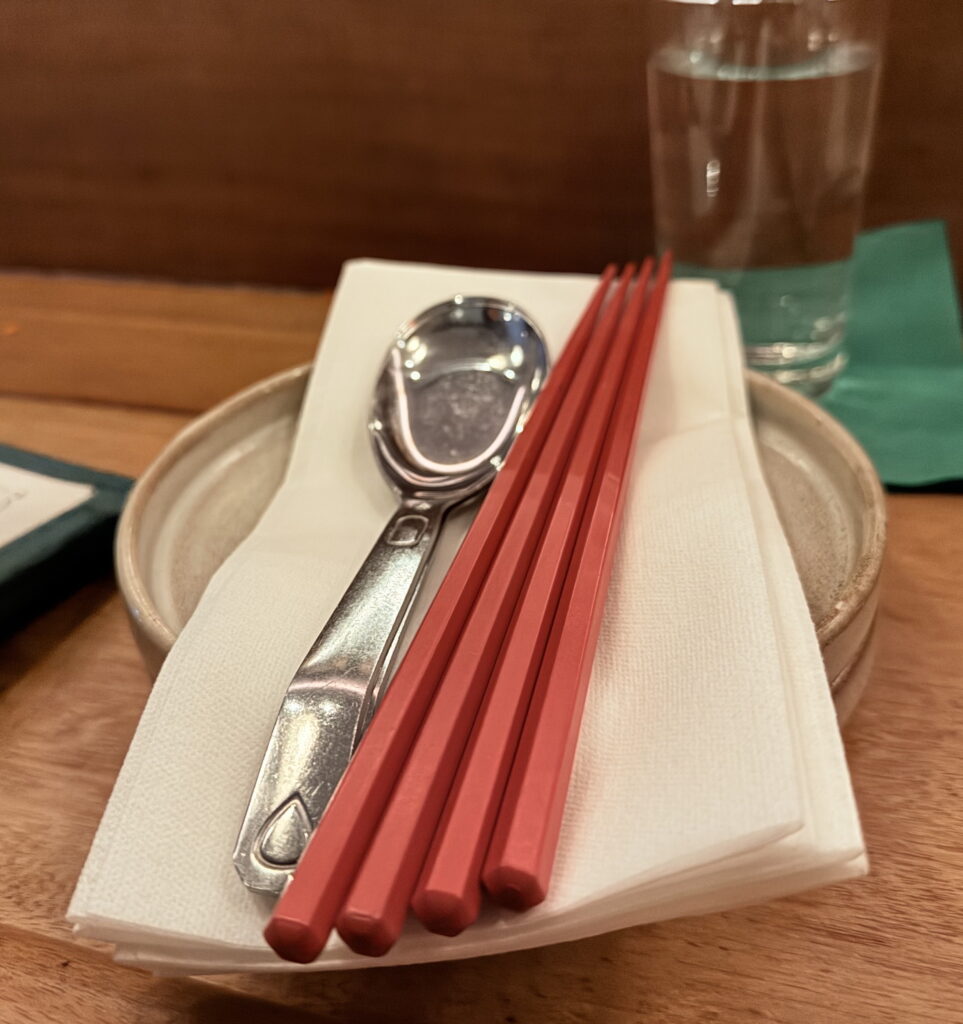

Red is considered an auspicious color in many Asian cultures. But it comes in very different shades, depending on where you are.
The darker, slightly earthy, muddy, brickish red you see in these chopsticks is uniquely Taiwanese. I asked ChatGPT to find a hex code and it gave me #9B2C2C or #B22222. Some people casually call this “pig liver red,” and you’ll find this tone on chopsticks, bowls, plastic stools, and temple decor (like below).
I love the attention the owners pay to details like this. Extra credit to Wen Wen for that!
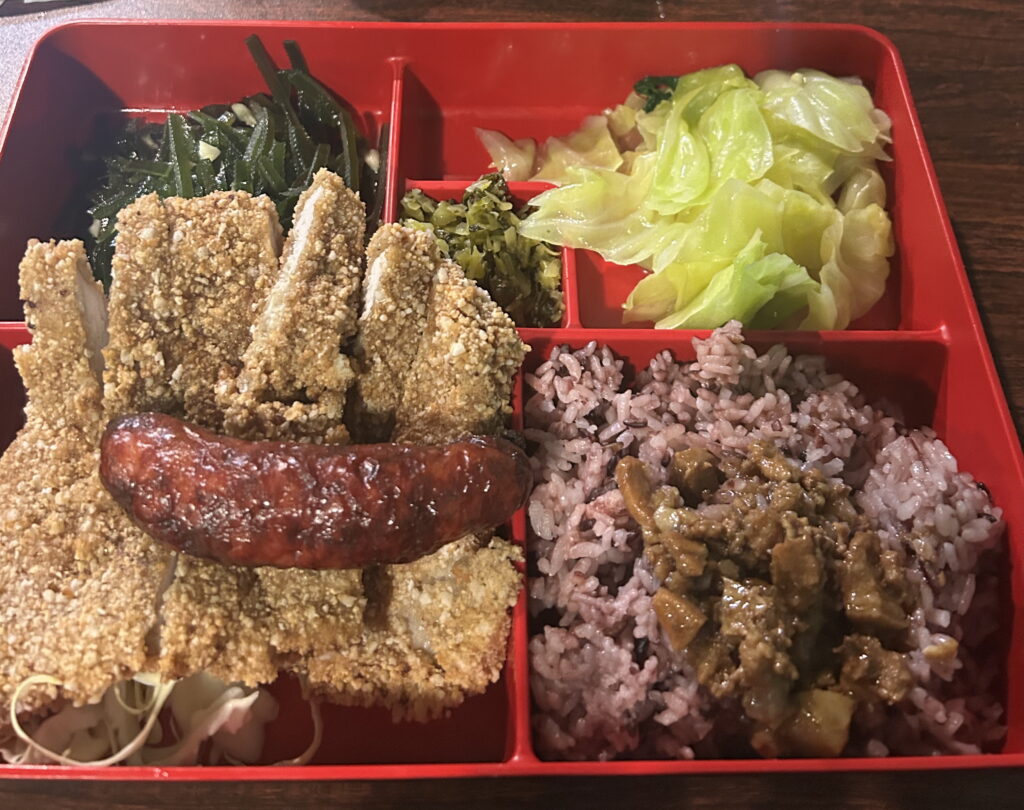
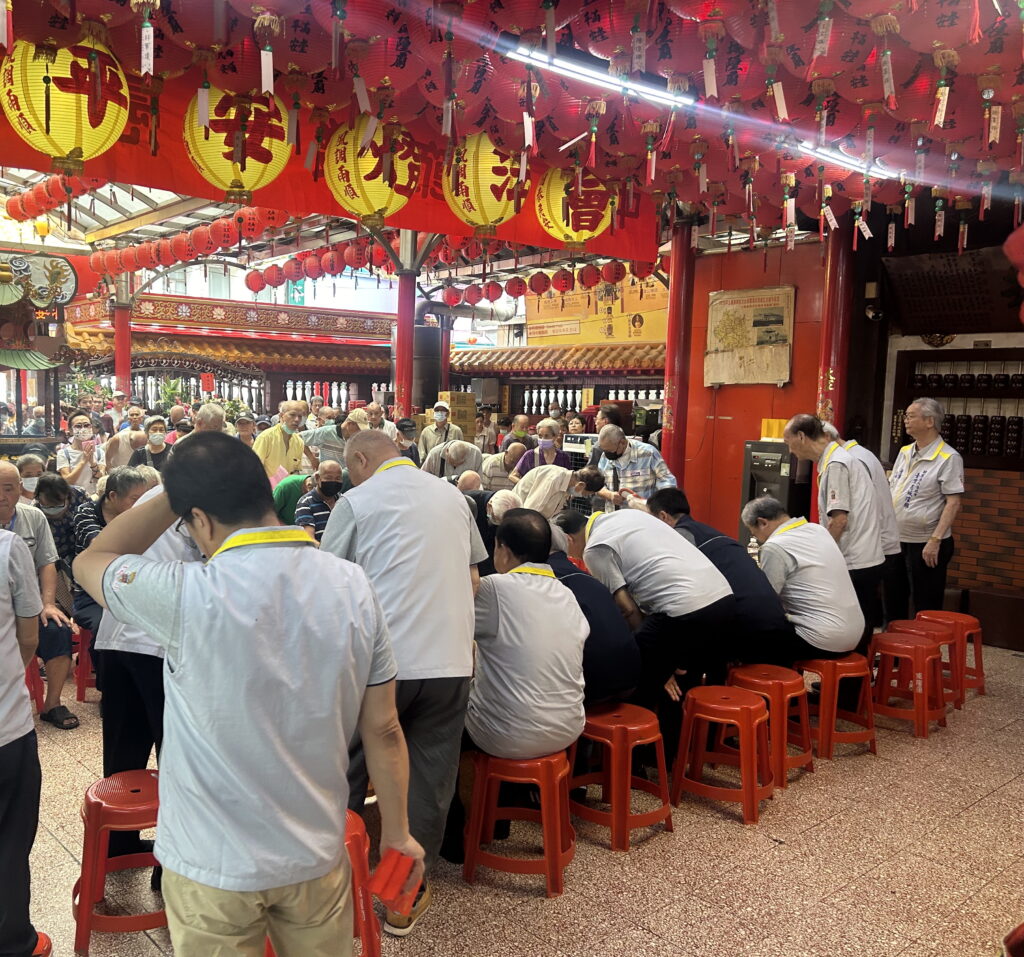
Worth another visit!
There are many things on the menu I’d love to try, and I’m jotting them down for my next trip.
- Peashoots w/ Tofu Skin 豆苗百葉
- Beef Noodle Soup 紅燒牛肉麵
- Lily Flemming Fried Rice 粒粒分明炒飯
- Whole BDSM* Fried Chicken 去骨豆乳全雞
Overall, Wen Wen is cozy, trendy, and oh so delicious. I’ll be sure to make another visit next time I’m in town!
Leave a Reply